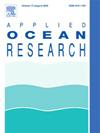Experimental investigations of local scour around piles in a single-column and three-columns with multiple rows in steady current
IF 4.3
2区 工程技术
Q1 ENGINEERING, OCEAN
引用次数: 0
Abstract
Local scour around pile groups is a common phenomenon in fluvial and coastal engineering, leading to a reduction in the bearing capacity of pile foundations frequently. In this study, experimental tests were conducted in a flume to investigate local scour around piles arranged in tandems of single-column and three-columns, with rows ranging from 1 to 5. The objective was to examine the effects of upstream piles and lateral piles on local scour around downstream and central piles, respectively. Bed elevation profiles and temporal scour depths were measured and observed, respectively. The results revealed that sediment particles accumulated in the spaces between the third and the fifth rows in the 5 × 1 configuration, while local scour holes extended into these areas in the 5 × 3 configuration. Temporal scour depths were successfully fitted to an equation that divides the local scour process into three stages: initial, developing, and equilibrium scouring. Piles on either side of the central piles contributed to larger and deeper scour holes compared to those observed in a single-column arrangement. Furthermore, the equilibrium scour depth was found to decrease linearly with an increasing number of pile rows. Coefficients for both single-column and three-column configurations were proposed to estimate reductions in equilibrium scour depths, based on well-fitted curves derived from the experimental data.
恒流条件下单柱和多排三柱桩周局部冲刷试验研究
群桩周围局部冲刷是河流及海岸工程中常见的现象,常导致桩基承载力下降。本研究在水槽中进行了试验试验,研究了单柱和三柱串列桩周围的局部冲刷现象,列数为1 ~ 5列。目的是分别考察上游桩和侧桩对下游桩和中心桩周围局部冲刷的影响。分别测量和观察了河床高程剖面和冲刷深度。结果表明,在5 × 1构型中,泥沙颗粒主要聚集在第3 ~第5排之间的空间,而在5 × 3构型中,局部冲刷孔向这些区域延伸。时间冲刷深度成功地拟合到一个方程,该方程将局部冲刷过程分为三个阶段:初始、发展和平衡冲刷。与单柱布置相比,中心桩两侧的桩造成了更大更深的冲刷孔。平衡冲刷深度随桩排数的增加而线性减小。在实验数据拟合曲线的基础上,提出了单柱和三柱配置的系数来估计平衡冲刷深度的减少。
本文章由计算机程序翻译,如有差异,请以英文原文为准。
求助全文
约1分钟内获得全文
求助全文
来源期刊

Applied Ocean Research
地学-工程:大洋
CiteScore
8.70
自引率
7.00%
发文量
316
审稿时长
59 days
期刊介绍:
The aim of Applied Ocean Research is to encourage the submission of papers that advance the state of knowledge in a range of topics relevant to ocean engineering.
 求助内容:
求助内容: 应助结果提醒方式:
应助结果提醒方式:


